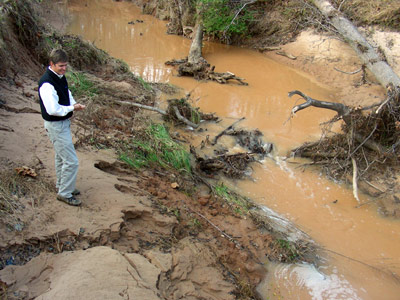

The Lick Creek Watershed Restoration Plan is funded by the NC Division of Water Quality's Section 319 Nonpoint Source Grant Program.

Sedimentation from urban runoff has impaired the functionality and water quality of Lick Creek.
There are several reasons to create a watershed restoration plan for Lick Creek:
- NC Division of Water Quality has listed Lick Creek as "impaired" because it does not adequately support aquatic life;
- Lick Creek flows to Falls Lake (a public water supply);
- The watershed lies within Durham City and County and Wake County, all of which must comply with federal stormwater regulations; and
- The watershed is planned for significant future urban development.
Project Goals
In order to protect water quality and habitat in Lick Creek and Falls Lake, the Lick Creek Partners and Stakeholders agree (see the May 9 meeting summary) that the following goals should be accomplished.
- GOAL 1: Develop a hypothesis about the causes of biological impairment in Lick Creek and recommend approaches to addressing impairment status.
- GOAL 2: Identify pollutants and their sources that may be impairing aquatic habitat and water quality in Lick Creek (water quality is not impaired currently). Suspected pollutants include dissolved oxygen (and biochemical oxygen demand), fecal coliform and turbidity.
- GOAL 3: Develop strategies for reducing, and maintaining at levels meeting water quality standards, the pollutants identified in Goal 2.
- GOAL 4: Mitigate future changes to watershed hydrology and water quality.
Meeting these goals necessitates a technically defensible and comprehensive watershed management plan.
The Planning Process
The Lick Creek Project Partners and Stakeholders are working together on the following steps:
- Define the goals that will guide the project and the plan;
- Gather watershed information and data and establish monitoring plan;
- Conduct GIS analysis and fieldwork to identify restoration opportunities; (click here to see fieldwork results)
- Conduct basic pollutant modeling and analysis of subwatersheds;
- Prioritize restoration, retrofit, and preservation projects;
- Recommend potential restoration and management strategies;
- Draft Lick Creek Watershed Restoration Plan; and
- Project partners may implement several of the plan's recommended strategies (such as stream and/or watershed restoration projects, retrofits of existing development, or code and ordinance changes).





